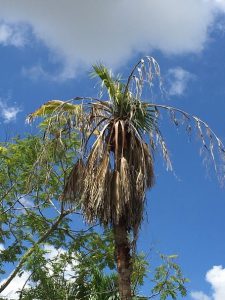Are you noticing that the big and tall Washingtonia palm (Washingtonia robusta) are dying in the landscape? Lately, I am seeing a lot of damage in Miami-Dade and Broward counties. The cause of the problem is a disease cause by the fungus Fusarium oxysporum f. sp. Palmarum. The common name is Fusarium wilt which is a very host specific disease. Primary it kills Queen palms (Syagrus romanzoffiana) and Washingtonia palms. It is close related to Fusarium oxysporum f. sp. Canariensis who kills Canary Island date palms (Phoenix canariensis).
The fungus causes a vascular wilt of the palm (figure 1). Specifically, it obstructs the xylem (water-conducting) tissue which results in the symptoms of leaf desiccation and quickly death. As with most diseases, Fusarium wilt symptoms are progressive. For Washingtonia palms, there will be at least one older leaf with a mixture of healthy, chlorotic, and necrotic leaflet segments in the leaf blade (figure 2).


The disease symptoms normally begin on the lowest (oldest) leaves and move up the canopy, progressively killing younger leaves (figure 3). The spear leaf is the last leaf to die. Death from Fusarium wilt occurs very quickly, with palms often dying within two to three months after initial symptom development. Due to the quick decline, a very characteristic symptom of this disease is the overall canopy appearance. The necrotic leaves do not droop or break and bend down around the trunk, but remain relatively rigid (Figure 4 and 5). The initial field diagnosis can often be made based on the symptoms described above. No other fungal disease kills the entire palm canopy so quickly.



To confirm the field diagnosis, a laboratory must isolate the pathogen from the affected leaf tissue and then conduct a molecular test on the isolated culture. There are numerous F. oxysporum isolates that do not cause disease that are still associated with palm material. Unfortunately, it is not possible to separate pathogenic isolates from nonpathogenic isolates based on their appearance in culture. Thus, isolation of a fungus that looks like F. oxysporum does not confirm the field diagnosis. The fungus growing on the culture plate is then subjected to a molecular test that can confirm if the fungus is F. oxysporum f. sp. Palmarum.
Once the palm is affected by this disease, there is no cure. Currently, there is no method for preventing this disease, either. Based on observations in Florida, the pathogen appears to be spread primarily by airborne spores (conidia) moved by wind, and possibly birds or insects. Once the disease is established in a landscape or nursery, it is thought that the disease may be transmitted from palm to palm via pruning equipment. The fungal pathogen is located in the vascular tissue of the leaf. The equipment used to remove leaves from an infected Washingtonia palm like chain saw, lopper, pruning shear, and hand saw will possible have the fungus. For that reason, the equipment should be cleaned and disinfected using materials like bleach, alcohol and pine-sol (Table 1). It is important to note that a palm could be infected but appear healthy (symptomless) because the disease has not developed to the point that leaf symptoms are being expressed.
Pruning should be restricted to removal of dead or dying leaves only. Severe pruning weakens palms and may increase the risk of pathogen transmission. Pruning should be viewed as a risk factor for Fusarium wilt disease transmission and not as a benefit to the palm.
Source: Fusarium Wilt of Queen Palm and Mexican Fan Palm, Dr. M. Elliott FLREC/UFhttp://edis.ifas.ufl.edu/pp278
 0
0
